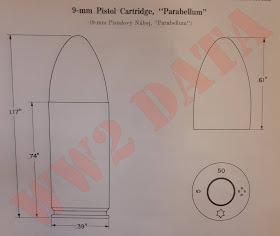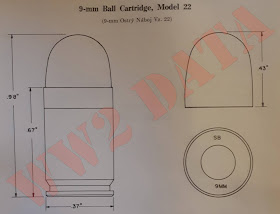Examination of Czechoslovakian Ammunition Production/Inventory
Mortar Ammunition
The Skoda establishment of Czechoslovakia has produced two original post-World War II mortars: the 82mm mortar Model 1948 and the 120mm mortar Model 1948. Both mortars are separable into pack units and are used for mountain infantry support. They are used by the Ethiopian Army and the 82mm M1948 is used in the Czechoslovak Army, but whether or not the 120mm M1948 is also in service with the Czech Army is unknown.
Formerly, the Skoda concern produced the Czech 50mm light mortar; mortars of this caliber, however, are no longer standard. Czechoslovakia has also produced German mortars and ammunition from 1938 to 1945.
The USSR has provided the Czech Army with cerain Soviet mortars in some quantity. The Soviet 82mm battalion mortar M1941, 106mm mountain-pack regimental mortar M1938, and 120mm regimental mortar M1938 are considered standard in the Czech Army. The Soviet 160mm mortar M1943 has also been reported as being used by the Czechs, but the extent of use has not been ascertained. Ammunition of Soviet origin for these weapons will doubtless be found in the Czech Army, although Czech-made Soviet shells may be more common.
The German 81mm mortar M1934 and the 120mm mortar M1942 (a copy of the Soviet 120mm mortar) are still used by the Czech Army. British 2-inch and 3-inch mortars are reportedly held in a reserve status. Whether ammunition for these weapons (except the German 120mm, which can fire Soviet shells) is restricted to stockpiles dating from World War II, or whether it is currently being produced in limited quantities, is unknown. The German 81mm has been modified to fire 82mm ammunition. In addition, the Czech 82mm M1948 is in use in the Army.
The Czech mortar ammunition described in the following comprises the rounds for the Czech-manufactured 82mm mortars which are used by the Ethiopian and Czech armies and the 120mm used by the Ethiopian Army. The ammunition is of conventional design and presents no outstanding features. The colors of the ammunition components and the packing box have not been reported. The stenciled markings are in French. If these items were used by another country, in all probability the language used would change accordingly.
82mm Mortar Shell, HE
(Czechoslovak Nomenclature Unknown)
(Czechoslovak Nomenclature Unknown)
This steel, eight-finned, high-explosive projectile is fired from the Czech-made (Skoda) 82mm Model 1948. The weapon is in use by Ethiopian and Czechoslovak armies.
The round is of conventional teardrop shape, but incorporates no gas check bands on the bourrelet. It uses a point detonating impact fuze and a shotgun-shell-type ignition cartridge. The ignition cartridge body is made of cardboard and contains 7.5 grams of powder. The propellent increments come in plastic (celluloid) cases and contain 7.8 grams of powder each. The ignition cartridge alone produces an initial velocity of 220 feet per second; the ignition cartridge plus six increments produces an initial velocity of 722 feet per second.
Stenciled markings on the shell indicate its caliber and type, the type of explosive filler, the date of manufacture, the arsenal symbol, the weight classification, and the fuze model used. The cap of the fuze is stenciled to indicate the caliber and type of shell and the fuze model (Mp 36).
If the shell is also used by countries other than Ethiopia, the identification markings would probably vary with the using country. The markings shown are the export version sold to Ethiopia by Czechoslovakia.
Characteristics
Caliber: 82mm (3.23 in)
Weight of complete round: 3.35kg (7.39 lb)
Weight of propellent: 54.3g (1.91 oz)
Type of filler: TNT
Weight of filler: ? kg (? lb)
Maximum number of increments: 6
Packaging
Packaging
Three of these shells complete with fuzes, ignition cartridge, and propellent increments are packed in a wooden carrying case. The case has a handle at the front end and a metal eye at the rear end for hand carrying or animal transport. The top of the box has two hinges in the rear and is secured by two snap locks in front. The dimensions and weight shown above are approximated measurements. The French markings given above are found on packaging in use by Ethiopia, the only country besides Czechoslovakia definitely known to use this ammunition.
120mm Mortar Shell, HE
(Czechoslovakian Nomenclature Unknown)
This steel, twelve-finned, high-explosive projectile is of conventional teardrop design. It is fired from the Czech-designed and made (Skoda) 120mm mountain pack mortar M1948, which is intended for mountain infantry support. At present this weapon is used by the Ethiopian Army; whether it is used by the Czech Army is unknown.
(Czechoslovakian Nomenclature Unknown)
The shell uses a 31-gram shotgun-shell-type ignition cartridge, bagged propellent increment charges, and a point detonating impact fuze Model Mp Z 36. The shell has an average wall thickness of 0.6 inch. The protective cap on the fuze must be removed prior to firing. The fuze may be set for either instantaneous or 0.08-second delay action by positioning the nose of the fuze to align an arrow with an index. The propellent increment bags are secured to the fin shaft by a loop of string (fastened to one end of the bag) which is placed over a ball formed by the opposite end of the bag. Charge 1 includes the ignition cartridge and 100 grams of propellant in a red bag. Charges 2, 3, and 4 include Charge 1 plus one, two, or three green-bagged increments of 135 grams each. At a normal rate of six rounds per minute, performance of the shell varies from a range of 450 meters and an initial velocity of 115 meters per second with Charge 1, to a range of 5,000 meters and an initial velocity of 255 meters per second with Charge 4.
Stenciled markings on the shell indicate its caliber and type, the type of explosive filler, the date of manufacture, the arsenal symbol, the weight classification, and the fuze model used. The fuze is stencil marked to indicate the caliber and type of shell and the fuze model (Mp Z 36). The base and walls of the ignition cartridge are reportedly marked to indicate the cartridge and powder types. If the shell is also used by countries other than Ethiopia, the identification markings would probably vary with the using country.
Characteristics
Packaging
Characteristics
Caliber: 120mm (4.72 in)
Weight of complete round: 16.2kg (35.71 lb)
Weight of propellent: 536g (18.9 oz)
Type of filler: Cast TNT
Weight of complete round: 16.2kg (35.71 lb)
Weight of propellent: 536g (18.9 oz)
Type of filler: Cast TNT
Weight of filler: 2.35 kg (5.18 lb)
Maximum number of increments: 4
Packaging
This shell is packed two complete rounds to a wooden box. The box weighs 15.87 pounds empty, has a metal carrying handle at each end, metal hinges, and is secured in front by two metal catches. It has two metal rings by means of which it can be tied to a pack animal. Two boxes form one pack load. The interior surface of the box is coated with grease, and the exterior surface is painted olive drab. The shell are packed fuzed. The ignition cartridges and propellent increments are packed in cylindrical metal cans. The dimensions and weight shown above are approximate measurements. The only markings on this box so far reported have been in French as shown above. The only country definitely known to use this ammunition is Ethiopia.
Next Time: Soviet Satellite Country Ammunition - Czechoslovakia (Part 6)
Source: Original US-supplied Canadian Manual on Soviet & Soviet Satellite Explosives (No. 30-14-2)
















